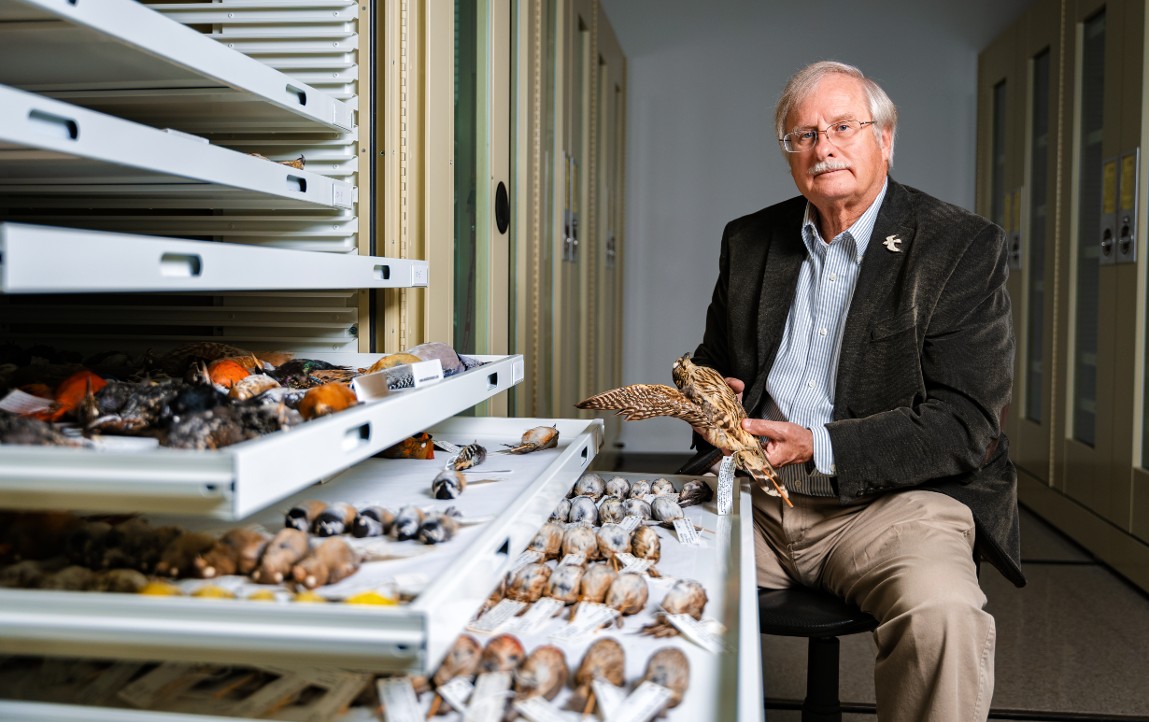Muhlenberg Bird/Glass Collision Research Featured in 'National Geographic'
Glass is even more deadly to birds than previously thought, according to a new peer-reviewed study led by Professor of Ornithology Daniel Klem. But, unlike many environmental problems, the solutions are simple.By: Kristien Yahna Todaro Thursday, June 6, 2024 05:14 PM
 Professor Daniel Klem is the director of the Acopian Center for Ornithology which houses a 2,000+ piece mounted bird collection, whose specimens average 100 years old and include many threatened, endangered and even extinct species. Photo: Joe Romano/Muhlenberg College
Professor Daniel Klem is the director of the Acopian Center for Ornithology which houses a 2,000+ piece mounted bird collection, whose specimens average 100 years old and include many threatened, endangered and even extinct species. Photo: Joe Romano/Muhlenberg College
New research, recently published in The Wilson Journal of Ornithology and featured in National Geographic, shows the annual death toll of birds crashing into glass may have been severely underestimated in the past.
For the last half century, Daniel Klem, Sarkis Acopian Professor of Ornithology and director of Muhlenberg’s Acopian Center for Ornithology, has been at the forefront of research on bird collisions with glass. His latest peer-reviewed study, with co-authors Ornithological Specialist Peter G. Saenger and former student researcher Brandon P. Brogle '20, shows bird deaths from window strikes are more than three times previous estimates.

An imprint from a mourning dove colliding with a window. Photo: Peter G. Saenger
The following excerpts are from the June 5 National Geographic article “This invisible killer takes out 3.5 billion U.S. birds a year.” Subscribers can access the full article via the link:
THUD.
When a bird smacks into a glass window, the force is nothing short of shocking. Panes rattle. Bones break. Brains bleed.
However, only a small percentage of birds die upon impact, with many regaining consciousness and flying off wounded, while an unknown number of those are carried off by predators. This makes the phenomenon hard to study.
Now, new, more in-depth research shows we may be severely underestimating the annual death toll of U.S. birds crashing into glass.
Previous research had relied on counting birds found dead next to windows and other glass structures. But the researchers took that a giant step further by observing birds in real-time for five years, in addition to studying bird-rehabilitation data.
The results, published recently in The Wilson Journal of Ornithology, suggest between 1.28 billion and 3.46 billion birds die in glass collisions each year. That number, which represents a 350 percent increase over the previous estimate in 2014, is just for the United States—meaning the global impact is likely many, many times higher.
“The whole bloody world is filled with glass right now,” says study leader Daniel Klem, an ornithologist at Muhlenberg College in Pennsylvania…
The Muhlenberg researchers found that while only 14 percent of collisions resulted in an immediate fatality, additional data they gathered from 10 animal-rehabilitation facilities across the U.S. Northeast and Great Lakes regions showed 70 percent of the birds brought to a facility because of a window collision ultimately perished.
The College research team tests products that can be placed on glass to make it more visible to birds — advanced treatments for new, large-scale building projects as well as inexpensive and DIY options for homeowners and renters.

Ornithological Specialist Peter G. Saenger and Professor Daniel Klem stand near the windows of Muhlenberg College's Fahy Commons, which feature bird-friendly glass coating.
“Ninety-nine percent of all the windows in the world are reflective,” says Klem, who also wrote Solid Air: Invisible Killer—Saving Billions of Birds from Windows. “Even a perfectly clear pane covering a darkened interior space acts like a mirror on the outside.” This leads to collisions when that surface reflects trees or the sky—the birds simply think they’re flying toward more habitat, not a solid material.
The species affected are diverse, as well: In Klem’s Pennsylvania study, more than a dozen species of birds struck the experimental windows, such as mourning doves, downy woodpeckers, red-winged blackbirds, northern cardinals, dark-eyed juncos, and Cooper’s hawks…
“This is not complex stuff, right? It's not climate change. It's not multifaceted unknowns,” says Klem. “We know how to solve this problem… We could [save the birds] tomorrow, if people were willing.”
